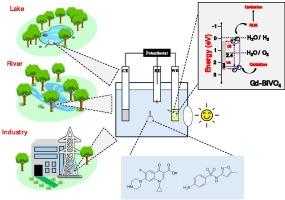Gd-BiVO4:一种利用太阳能光电催化降解污染水中药物的高效光阳极
IF 13.2
1区 工程技术
Q1 ENGINEERING, CHEMICAL
引用次数: 0
摘要
本研究调查了钆插入原始钒酸铋(BiVO4)光阳极的情况及其对物理和光电化学(PEC)特性的影响,以及对利用太阳能光电催化从不同水样中去除环丙沙星(CIP)和磺胺甲恶唑(SMX)抗生素的影响。与纯电极相比,钆插入的光电流增加了 300%,而半导体重组率却降低了。这种性能是在不改变单斜 BiVO4 结构的情况下获得的,是由于 Gd-BiVO4 薄膜具有更好的均匀性,以及 Gd 对半导体体中氧空位形成的影响。将 Gd-BiVO4 薄膜应用于 CIP 和 SMX 抗生素的光电降解,采用 1 mA cm-2 的光电流密度和 0.063 mol/L 的 NaCl 作为支撑电解质,在 20 分钟内实现了对两种抗生素的完全去除。在实际样品(河流、湖泊和废水)中,Gd-BiVO4 光阳极表现出良好的性能,主要用于 CIP 降解。该催化剂经过 5 次循环使用,在降解 CIP 和 SMX 方面表现出优异的活性,并且在应用过程中没有发生表面成分变化。我们的研究结果表明,在 BiVO4 结构中加入钆可以使光电催化应用中的光阳极更加稳定和适用。本文章由计算机程序翻译,如有差异,请以英文原文为准。

Gd-BiVO4: An efficient photoanode for pharmaceuticals degradation in contaminated waters via solar photoelectrocatalysis
This study investigated Gd insertion into pristine bismuth vanadate (BiVO4) photoanodes and its influence on physical and photoelectrochemical (PEC) properties, as well as on ciprofloxacin (CIP) and sulfamethoxazole (SMX) antibiotics removal from different water samples using solar photoelectrocatalysis. The Gd insertion increased by 300 % at photocurrent compared to the pure electrode and decreased at the semiconductor recombination rate. This performance was obtained without change into monoclinic BiVO4 structure and resulted from a better Gd-BiVO4 film uniformity and a Gd effect on oxygen vacancy formation at the semiconductor bulk. Gd-BiVO4 film was applied to CIP and SMX antibiotic photoelectrodegradation, and a complete removal of both antibiotics was achieved in 20 min by applying 1 mA cm−2 of photocurrent density and using NaCl 0.063 mol/L as supporting electrolyte. In real samples (river, lake and wastewater) the Gd-BiVO4 photoanode exhibited good performance, mainly for CIP degradation. The catalyst was recycled in 5 runs and exhibited excellent activity for degrading CIP and SMX, and it did not undergo surface composition change during the process application. Our results demonstrate that Gd insertion into the BiVO4 structure leads to a more stable and applicable photoanode for photoelectrocatalysis applications.
求助全文
通过发布文献求助,成功后即可免费获取论文全文。
去求助
来源期刊

Chemical Engineering Journal
工程技术-工程:化工
CiteScore
21.70
自引率
9.30%
发文量
6781
审稿时长
2.4 months
期刊介绍:
The Chemical Engineering Journal is an international research journal that invites contributions of original and novel fundamental research. It aims to provide an international platform for presenting original fundamental research, interpretative reviews, and discussions on new developments in chemical engineering. The journal welcomes papers that describe novel theory and its practical application, as well as those that demonstrate the transfer of techniques from other disciplines. It also welcomes reports on carefully conducted experimental work that is soundly interpreted. The main focus of the journal is on original and rigorous research results that have broad significance. The Catalysis section within the Chemical Engineering Journal focuses specifically on Experimental and Theoretical studies in the fields of heterogeneous catalysis, molecular catalysis, and biocatalysis. These studies have industrial impact on various sectors such as chemicals, energy, materials, foods, healthcare, and environmental protection.
 求助内容:
求助内容: 应助结果提醒方式:
应助结果提醒方式:


